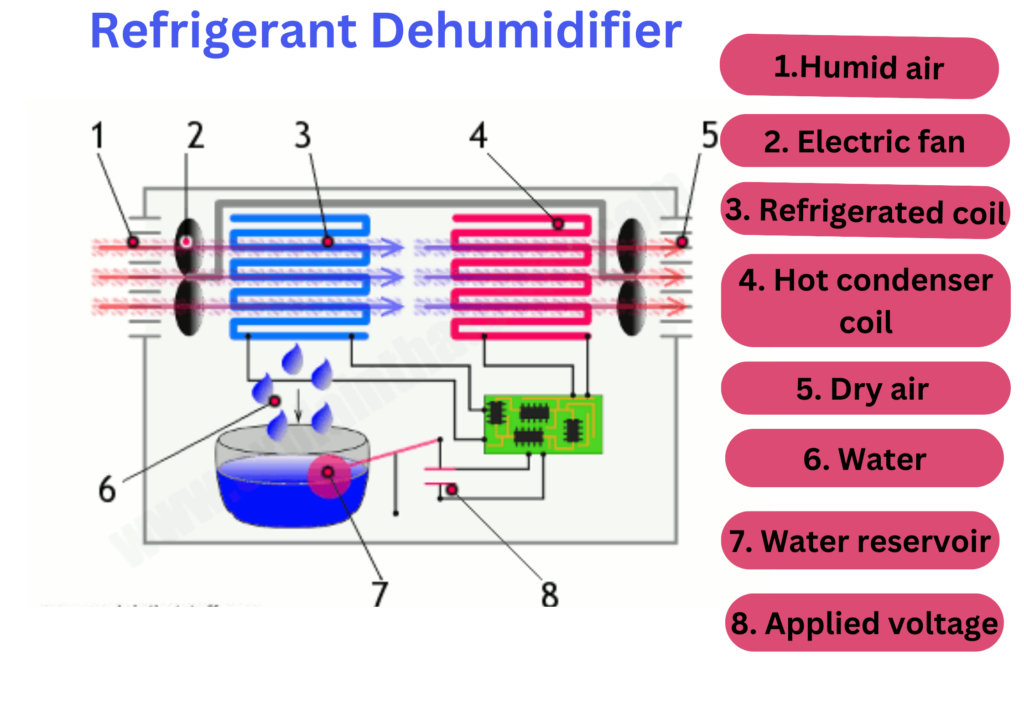A human needs some humidity to function normally, but extra humidity or moisture causes discomfort, illness, and damage to expensive household products. Extra moisture in the surrounding air causes the growth of mold and mildew. In this situation, a dehumidifier can help you remove the extra moisture from the air.
A dehumidifier makes breathing easier and enhances the air quality. It reduces allergic symptoms asthma, severe colds, coughs, etc. It also helps in saving your valuable belongings from getting damaged.
This article gives an overview of dehumidifiers, various types of dehumidifiers, their uses, benefits, and working principles, etc. Read on to get a clear idea”How Does a Dehumidifier Work?” and the importance of dehumidifiers in leading a healthy life.
What Is a Dehumidifier?
A dehumidifier is an electrical device that removes excess moisture from the air and maintains the humidity at the recommended level. It works by drawing in moist air from the surrounding area and passing the air over evaporator coils. The temperature of the coils is set below the dew point of the incoming air.
When the air passes over the cooled coils the condensation process starts and it pulls moisture from the air. The moisture collected by the coil drips into the reservoir. The dehumidifier reheats the air to remove extra moisture and circulates the drier air back to the room.
It helps prevent mold, mildew, and condensation in damp areas of a home and also removes unpleasant odors. It makes breathing easier and offers relief from asthma and allergic symptoms.
A dehumidifier helps people live in a naturally humid climate. It can cool off a room and reduce the use of air conditioners. It eliminates mold and dust from a room and creates a healthy environment.
Types of Dehumidifiers
There are mainly 3 types of dehumidifiers available in the market.
- Refrigerant Dehumidifier
- Desiccant Dehumidifier
- Whole house Dehumidifier
How Does a Dehumidifier Work?
How Does a Refrigerant Dehumidifier Work?
A refrigerant dehumidifier consists of 3 main components i.e. a fan, a refrigerated coil, and a hot condenser.
- Fan: A fan draws the humid air into the device.
- Refrigerated coil: It lowers the temperature of the air to remove moisture from it.
- Hot condenser coil: It makes the dry air warm before releasing it into the environment.
The working principle of a dehumidifier is represented below.
- Inside a dehumidifier, there is an electric fan that draws humid air into the dehumidifier.
- The humid air then passes over the refrigerated coil. As the air cools, its temperature decreases to its dew point. The condensation process starts and the moisture of the air transforms into water that is being collected in a collection tray.
- The dry air passes over the hot condenser coil, which warms back up to its original temperature. The air free of moisture is then released back into the environment.
Refrigerant dehumidifiers work best at a typical room temperature. They don’t work effectively in an environment that is too cold. This dehumidifier is ideal for temperatures between 15 to 39 degrees Celsius.

Desiccant Dehumidifier
A desiccant dehumidifier works on the principle of adsorption. This process uses an adsorbent or desiccant material that attracts and holds the water molecule onto its surface.
A desiccant dehumidifier mainly consists of 2 components.
Fan: An electric fan draws the humid air into the device.
Desiccant wheel: A desiccant wheel is in a constant rotation to remove moisture from the air.
The working principle of a desiccant dehumidifier is represented below.
- The electric fan draws in the humid air to the dehumidifier.
- The humid air is then passed through a desiccant wheel. A large desiccant wheel is in constant rotation and attracts the water molecules from the humid air and holds it on its surface.
- The dry air is expelled back into the environment.
- Then a second air stream is heated and passed through the wheel. This heated air stream removes the moisture on the wheel and makes it dry.
- The wheel is then reactivated again to continue the process of removing moisture from the air.

Whole house Dehumidifier
If you live in a place with a highly humid environment, then a whole-house dehumidifier is a great addition to your house. The air conditioning system takes a lot of load to first balance the humidity level of the air and then cool the air to circulate it inside the house. A whole-house dehumidifier is usually integrated with the central air conditioning system. A dehumidifier reduces the moisture from the air and thus lowers the load on the centralized AC system.
A whole-house dehumidifier controls indoor moisture and prevents mold growth in your whole house. It works as follows.
- The humid air first enters into the dehumidifier by an electric fan.
- The air is then passed over the evaporator coil. Then the condensation process starts which converts the water vapor in the air to water.
- The water falls out in the reservoir tank connected to a dedicated drain line to exit it from the home.
- The dry is then cooled by the air conditioner and circulated back into the indoor area.

Uses of dehumidifiers
Residential Use
A dehumidifier eliminates musty odors and prevents the growth of mold and mildew inside a home. It saves furniture, curtains, clothing, and several expensive things from getting damaged. The use of a dehumidifier also helps to dry out the clothes sooner.
The use of a dehumidifier in the bathroom helps to keep it dry and clean. It protects the valuable things inside a store room from getting rusted and warped. Thus, a humidifier can be used in the basement, garage, living room, and study room to remove moisture from the air and create a healthy home environment.
Commercial Use
Extra humidity can increase dust and allergens in the air. This affects the health and well-being of employees. The use of a dehumidifier along with a centralized air conditioning system or heating system of an office or, workspace removes moisture in the air. This improves the air quality of the surrounding air and also increases the comfort and productivity of employees.
Industrial Use
An industrial dehumidifier is a necessary device to maintain the inventory and equipment of plant warehouses, garages, workshops, and construction sites. Excess humidity in the air causes corrosion and damage to the tools and equipment. It can also damage edible and nonedible products in a store room.
A dehumidifier maintains the humidity at the optimal level and saves tools, equipment, and machinery from getting damaged. It also prevents the wall paint from bubbling and cracking.
Swimming Pools
The installation of a dehumidifier in the indoor swimming pool area maintains the recommended humidity level and creates a pleasant indoor pool environment for visitors and staff.
Benefits of Dehumidifiers
- Eliminate Dust Mites:
When the moisture level inside a home becomes high, it can also increase the amount of dust mites. This causes various health issues including allergic symptoms, asthma, and respiratory diseases. A dehumidifier removes extra moisture from the air and helps to eliminate dust mites. Thus, it makes breathing comfortable and easier.
- Prevents Mold and Mildew Growth:
The growth of mold and mildew are most prominent in dark and humid environments. A dehumidifier makes the air drier and prevents the growth and spreading of mold and mildew. Placing a dehumidifier in a room or basement can make the living arrangement more comfortable.
- Reduce Unpleasant odors
You can feel musty and unpleasant odors in a humid environment. A dehumidifier removes the extra moisture from the air and makes it smell fresher and healthier.
- Cost efficient:
When a humidifier works in a room along with an air conditioner, the load on the air conditioning system to cool the room becomes easier. The humidifier removes extra moisture from the air and the air conditioning unit does not have to deal with the moisture in air. Thus, the air conditioning system consumes less energy to cool the room and it improves the lifespan of the system.
- Protects Valuable Belongings:
The use of a dehumidifier can protect your valuable belongings from being affected by mold, fungus, dust mites, water damage, etc.
- Prevent Warping and Rusting:
High moisture in a home can lead to rusting metals and warping wood. A whole-house dehumidifier can save costly things like door frames, bikes, vehicles, etc. from getting damaged.
- Cloths Dry Out Faster:
A dehumidifier extracts moisture from the surrounding air and can also evaporate moisture from the fabric faster. Thus, it helps in drying out clothes sooner.
Conclusion
If you live in a more humid climate or coastal region, or the relative humidity level of your home is greater than 50 % then a dehumidifier is the best addition to your home. The use of a dehumidifier has several health benefits. It can make breathing easier and offers relief from various respiratory diseases including asthma, allergic infections, etc. It reduces dust mites, mold, and allergens, and also helps eliminate unpleasant odors from the surrounding area.
Various types of dehumidifiers are available in the market such as refrigerant dehumidifiers, desiccant dehumidifiers, whole-house dehumidifiers, etc. Select the perfect one based on your requirements. I must say the addition of a dehumidifier in your home might make a difference in the comfort level you experience at home.
FAQS
- What’s the difference between a humidifier and a dehumidifier?
A humidifier is used to add moisture into the air and a dehumidifier removes extra moisture from the air. According to the U.S. Environmental Protection Agency the ideal relative humidity level of the indoor air should be maintained between 30% to 50%.
Both of these devices are used to maintain the relative humidity of the surrounding air at the optimal level. A humidifier is used in winter, or cooler climates to avoid dryness in the air. A dehumidifier is generally used in humid climates, or coastal areas to reduce the extra moisture from the surrounding air.
2. How long should you run a dehumidifier?
You should run the dehumidifier till the relative humidity level of a room reaches between 30% to 50%. So, on average you have to turn on the dehumidifier for half of the day. But in a highly humid environment like a bathroom, it would be best if you run a dehumidifier all day.
Also Read
- 10 Tips for Buying a Dehumidifier
- Dehumidifier Vs Air Purifier 2024
- Dehumidifier vs. Air Conditioner 2024
- Cool Mist Humidifier: Types, Uses, Benefits, Working Principle 2024
- Do Humidifiers Help with Air Quality? 2024
- When Do You Need a Humidifier? 8 Common Signs
- How Do Humidifiers Work? A Complete Guide 2024
- How Humidifier Helps Breathing? 2024
- Humidifier Vs Dehumidifier Vs Air Purifier: Which One Should You Buy? 2024


15 thoughts on “How Does a Dehumidifier Work? Complete Overview”